Lesson 4: Slow Flight
Okay, here’s the deal. I’m going to stick you in an airplane that’s capable of doing 120 knots—twice as fast as most cars on the freeway below—and I have only one request: I want you to fly as slow as you can. Sounds reasonable, right? Not really. This is like asking an Indy 500 racecar driver not to take his machine out of first gear. There is, however, a good reason for flying slowly.
The practice of slow flight is the proving ground in which you prepare for aviation’s biggest event: landing. After all, you don’t want to land at cruise speeds, because airplanes weren’t designed to maneuver on the surface at high velocities. You don’t want to burn the tires off the rims, do you? (Just kidding, but it’s not far from the truth.) In general, the slower you are upon touchdown, the easier it is to control the airplane on the runway.
Additionally, airplanes can’t fly too slowly, or they’ll cease flying and start falling (this is called stalling, but it has nothing to do with the engine stopping, as you’ll later learn). That’s why I want you to feel comfortable operating at slower speeds so you’ll know where the dangers are. And, as you’ll eventually discover, it’s sometimes necessary to follow slower airplanes. You need to know how to adjust your airspeed to prevent chewing up their tail feathers. These are only a few of the reasons we practice slow flight. It’s an important maneuver. Let’s get started by discussing how airplane wings develop lift.
目次
- The Wing and Its Things
- How the Wing Works
- Relative Wind
- Attacking the Air
- How Lift Develops
- Impact vs. Pressure Lift
- Bending the Wind with the Wing
- Angle of Attack and the Generation of Lift
- Slow Flight in Action
- Leaving Slow Flight
- Maintaining Altitude at Cruising Speed
- You’re on Your Own
- ESTIMATED TIME TO COMPLETE
- REQUIRED KNOWLEDGE/SKILLS
- THE WEATHER
- RECOMMENDED CHARTS
- ABOUT THE FLIGHT
- KEY COMMANDS TO REMEMBER
- FLIGHT CRITERIA
The Wing and Its Things
In ground school many years ago, my instructor asked me about the origin and definition of the word “wing.” I replied, “Ma’am, I think it means ‘the arm of a bird’.” She mumbled something about why many animals eat their young at birth and then went to the dictionary to look up the definition. Wing was defined as “a moveable, paired appendage for flying.” She looked at me and said, “Well, what does that sound like to you?” I said, “Well, ma’am, that sounds like the arm of a bird to me.” We agreed to disagree, even though I was right.
The wing has several distinct parts: the upper cambered surface, lowered cambered surface, leading edge, trailing edge, and chord line (Figure 4-1).
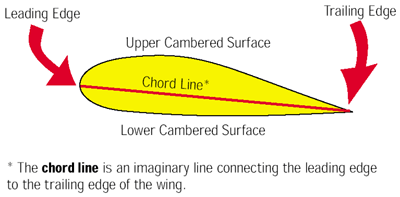
Notice that the upper cambered (meaning curved) surface seems to have a greater curve to it than the lower cambered surface. This isn’t accidental. In fact, this is so important that we’ll talk about it in detail shortly.
Perhaps the only term whose definition isn’t intuitively obvious is the chord line. The chord line is an imaginary line connecting the wing’s leading edge with its trailing edge. Believe me, there is no line inside the wing that looks like this. It’s only imaginary, just like the arrows showing the four forces in Lesson 1. When the shoe salesperson points to your foot and says, “Your toe is here,” you want to respond by saying, “Thanks, I’ve been looking for that.” In reality, he or she is pointing out the position of something not visually obvious. The chord line does something similar. Given the wing’s curved surfaces, it’s difficult to tell which way the wing points. Since engineers don’t like uncertainty, they agreed that the chord line will represent the general shape of a wing.
How the Wing Works
To understand lift, you must visualize how the wing attacks the air. Aeronautical engineers talk about the wing contacting, or attacking, the air at a specific angle. This occurs in much the same way a pit bull attacks a mailman—mouth first. What part of the wing does the attacking? Is it the leading edge? Is it the trailing edge? Or is it the bottom of the wing? This is where the definition of chord line becomes useful.
Because wings come in variable sizes and shapes (just like pilots), it is sometimes difficult to determine exactly how and where the wind strikes the wing. Fortunately, the chord line substitutes as a general reference for the shape of the wing. If I say that the wind blows onto the wing at an 18-degree angle, I’m saying that the angle between the wind and the chord line is 18 degrees (Figure 4-2).
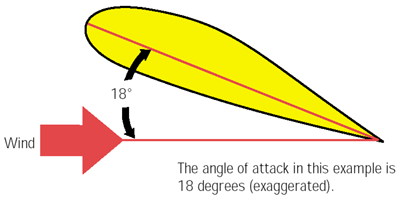
This distinction, although seemingly trite, is as important to an engineer as tightly stitched pant seams are to a matador.
Relative Wind
Only one more definition needs be absorbed before the secrets of lift are revealed. That term is called the relative wind (which is not a reference to an uncle who tells long stories without inhaling).
Movement of an airplane generates wind over the wing. This wind is called the relative wind because it is relative to (or results from) motion. For instance, in Figure 4-3, no matter which way the jogger runs, he feels wind in his face that’s relative (opposite and equal) to his motion.
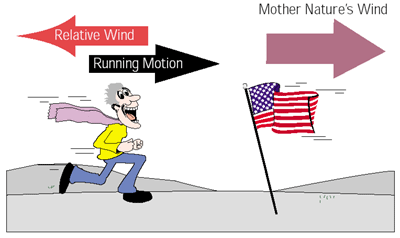
The relative wind is wind resulting from an object’s motion.
Despite the actual wind blowing from behind, the jogger
feels wind on his face as a result of his running motion.
Relative wind is relative (opposite and equal) to the
movement of an object.
Relative wind is movement-generated wind that’s equal to and opposite to the motion of the airplane. To illustrate this point, stick your hand out the window of a moving automobile (keep all other body parts inside, please). You’ll feel wind blowing opposite the motion of the car. Drive a car backwards on the freeway, and you will feel wind and hear a lot of horns blowing from directly behind you (you’ll also attract the police).
Move the airplane forward, as shown by Airplane A in Figure 4-4, and wind blows on its nose.
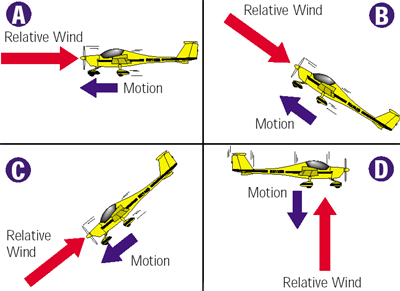
As a airplane climbs or descends (that is, moves up or down the imaginary hill we discussed in Lesson 2), relative wind still blows on its nose (Airplanes B and C). But if an airplane drops straight down, without a change in pitch, the relative wind blows on its belly (Airplane D). As far as Airplane D is concerned, the wind is blowing on its belly despite the level attitude. As for the passengers, they’re probably underneath the front seat in the fetal position making spiritual transmissions that don’t require a radio. Try not to scare your passengers. It isn’t nice, and they don’t like it).
The following point is so important, I want you to put one finger in your ear. Go ahead, do it before reading any further! I want you to do this because I don’t want this information to go in one ear and out the other. The important principle to remember is that relative wind is independent of which way the airplane’s nose is pointed. Relative wind is opposite in direction and equal to the airplane’s velocity. Let’s see how the wing actually attacks the wind to develop lift.
Attacking the Air
Hunting is a sport to some people. It’s also a sport where your opponent doesn’t know it’s a participant. Attacking an animal means that the hunter must point his weapon precisely at the prey. The hunter looks though the gun sight and sees the path of the bullet. An airplane is unlike a gun (and a car) in that its vertical climb path is different from its incline (the direction it points upward).
Remember that 750-foot tower off the end of the runway? On takeoff, if you point your airplane slightly above the top of that obstacle (like a rifle sight), it’s unlikely that you’re going to clear it. In fact, the only thing being cleared is the area—as the firemen try to talk you down from the side of that tower. Remember, airplanes with limited thrust have shallower climb paths—unlike some fighter jets.
The most important principle to understand here (put that finger back in the ear) is that the nose (therefore the wing) can be pointed on an incline that’s different from the actual climb path. An angle exists between the amount the wing is inclined and its climb path (you’ll soon see why). Remembering that the relative wind is always equal and opposite to the flight path, it’s more precise to say that an angle exists between the chord line and the relative wind. This angle is known as the angle of attack (Figure 4-5).
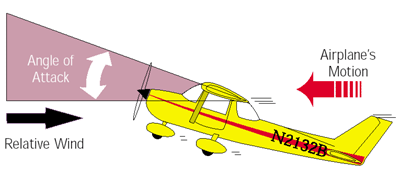
Figure 4-6 shows the wing (chord line) of Airplane A making a 5-degree angle to the relative wind.
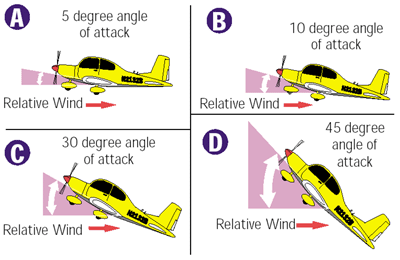
A more common way of saying this is that the wing’s angle of attack is 5 degrees. Airplanes B, C, and D show increasing angles of attack of 10 degrees, 30 degrees, and 45 degrees, respectively. The greater the difference between the wing and the relative wind, the greater the angle of attack. And, as you’re about to see, the wing’s lift is directly associated with its angle of attack.
How Lift Develops
The wing is the ultimate air slicer. As powerful as any Samurai sword or karate chop, it’s a precision device for slicing air in a specific way. Wings are expressly built to plow through air molecules, separating them either above or below, while offering little resistance in the horizontal direction. Any horizontal resistance slows the wing down. This horizontal resistance is called drag, and it’s definitely a case of less being better.
Figure 4-7 shows how the airfoil (a fancy name for a wing) splits the wind when it’s at a 10-degree angle of attack.
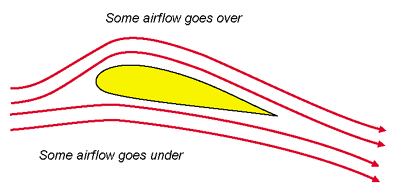
Lift from an airfoil is produced by air flowing over and under the wing
Airflow strikes the leading edge of the wing forcing some air over (and some under) the airfoil. Both the air flowing over and the air flowing under the wing are responsible for generating lift. Let’s first examine how the airflow striking the bottom of the wing produces some of the total lift that is developed.
Impact vs. Pressure Lift
Sticking your hand out the window of a moving automobile does two things: it demonstrates how a relatively flat surface develops lift, and it signals a left turn. Figure 4-8 shows how wind is deflected downward when it strikes your hand.
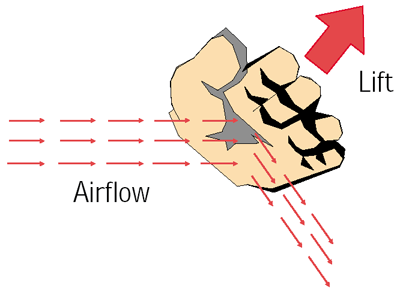
According to Sir Isaac Newton, who knew about such things, for every action there is an equal and opposite reaction. Wind deflected downward by the airfoil creates an upward (opposite) movement of the wing. This upward movement is caused by the impact energy of billions of tiny air molecules striking the underside of the wing. Also, higher pressure on the bottom surface of the wing results from this molecular impact. The wing moves upward as if it were being pushed from below.
This type of lift is known as barn door lift, or impact lift. It generally contributes only a small portion of the total lift produced by the wings, which means that man and woman do not fly by barn-door lift alone. If we could, it would mean eccentric people would report flying barn doors instead of UFOs.
A more subtle and powerful form of lift occurs from curved airflow over the top of the wing.
Bending the Wind with the Wing
The Japanese invented the art of paper bending and called it origami. They then experimented with people-bending and called it judo. This art was not perfected, however, until the airlines adopted the practice, which is referred to as “flying coach.”
Airliners (indeed all airplanes) bend something else—they use their wings to bend the wind. Wind bending did not sound sophisticated enough to explain why airplanes fly, so it was given a fancy Greek title. We call wind bending aerodynamics. Simply stated, the wing is a precision device for bending or curving the wind downward.
But how does bending the wind over the wing create lift? Let’s find out. Figure 4-9 shows a cross section of an airfoil.
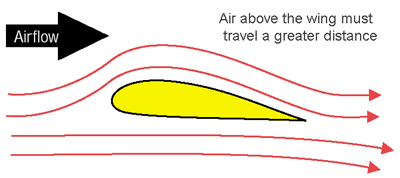
At low angles of attack, the air above the wing is curved while the air below the wing is relatively straight.
Examine its shape carefully. At small angles of attack, air flowing above the wing is bent, or curved, with great precision as it follows the upper cambered surface. A rather straight surface on the bottom of the wing leaves the air underneath relatively unbent. Bending, or curving, the wind above the wing forces air to travel a greater distance than the straighter airflow below. If the wind above is to reach the trailing edge at nearly the same time as the wind below (science and experiments say that it does), it must speed up to cover the greater distance.
For example, assume you are walking your pit bull terrier (named Bob) on a leash. You are on the sidewalk, and Bob is walking in the gutter (Figure 4-10).
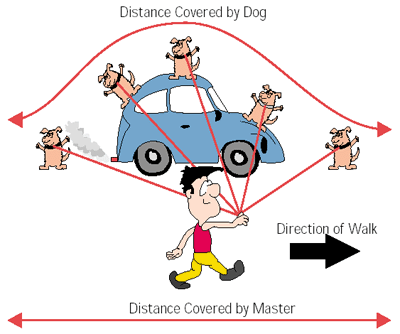
Bob encounters a parked Volkswagen and decides to walk over the car rather than around it (remember, he’s a pit bull… they’re stubborn). Obviously, the distance over the car is greater than the distance you will travel on the sidewalk. In order for Bob to avoid being choked by the leash, he will have to speed up slightly as he covers this greater distance.
Do you notice the resemblance of the VW’s profile to a wing? It’s curved on top and rather straight on the bottom. As air flows over the wing, it curves and speeds up.
Most wings are designed with their upper surface curved and their lower surface relatively straight. Because of the wing’s shape, even at a small angle of attack, a cambered wing still adds a slight curve and acceleration to the wind. This produces the lift you learn to love, particularly if you think an airplane should fly.
Thanks for the lift, Monsieur Bernoulli!
Something remarkable happens when air flowing over a surface increases its speed. In the late 1600s, a Swiss physicist named Jacob Bernoulli (pronounced ber-NEW-lee) figured out that the faster air flows over a surface, the less pressure it exerts on that surface. High-velocity airflow over a wing causes a slight decrease in pressure on the wing’s upper surface. In other words, the pressure on top of the wing is now less than the pressure on the bottom of the wing (Don’t ask why. It has to do with translational kinetic energy, and explaining that will give you something that feels like a two-scoop lobotomy). Known as Bernoulli’s principle, this wonderful trick is what keeps airplanes from being large and expensive doorstops.
Angle of Attack and the Generation of Lift
During takeoff on a commercial airliner, have you ever noticed that the pilot always raises the nose slightly to begin the climb after attaining a minimum forward speed? This is called rotation, and it isn’t something that’s done to the airplane’s tires.
As the airplane accelerates for takeoff, it eventually reaches a sufficient speed to begin flying. At this relatively slow speed, however, the wing’s engineered curve isn’t capable of curving, or deflecting, enough air downward to produce the necessary lift for flight. This is why the airplane doesn’t hop off the ground like a grasshopper that just landed on a hot barbecue. The pilot must do something extra to add an additional curve to the wind. Raising the nose slightly increases the angle of attack. This forces the air to undergo an additional curve greater than that which the engineered shape of the airfoil can produce. Figure 4-11 depicts this process.
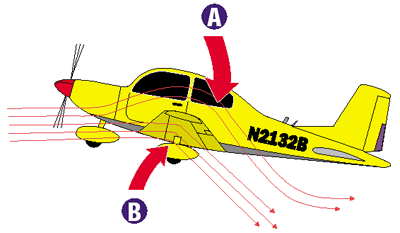
A-Lift from low pressure. At large angles of attack, the
airflow is forced to curve beyond the engineered shape
of the wing. B-Impact lift on the bottom of the wing
increases at a high angle of attack.
With this additional curvature, air travels a greater distance, its speed increases, pressure lowers on top of the airfoil, and sufficient lift to begin flying is produced at a slower airspeed (thanks for the lift, Bernoulli!). Greater impact lift results from increased exposure of the wing’s lower surface to the relative wind. The result is that an increasing angle of attack permits the airplane to produce the necessary lift for flight at a slower airspeed.
Now you know how airfoils generate the required lift at slower airspeeds. You also know why airplanes taking off or landing at slower speeds seem to have a rather nose-high attitude. But what happens at higher airspeeds? Have you noticed that in cruise flight at cruise airspeeds, airplanes fly at near-level flight attitudes?
Figure 4-12 shows an airplane at several different angles of attack.
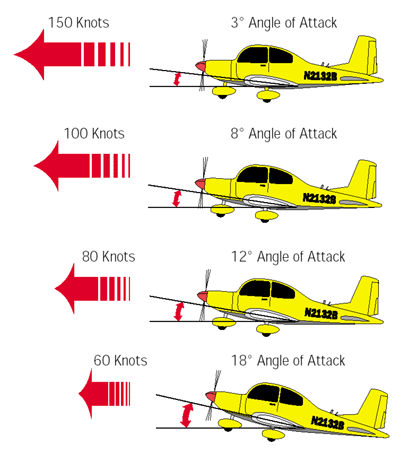
With speed variations in level flight, the relationship between the
angle of attack and airspeed is clearly shown.
With increasing airspeed, the airplane requires a smaller angle
of attack to remain airborne. As the airplane’s airspeed
decreases, a larger angle of attack in necessary.
At higher speeds, airplanes can fly at lower angles of attack because the wing’s shape generates sufficient lift. Slow the airplane, and the wing must artificially bend the wind by increasing its angle of attack.
An intimate and sizzling relationship exists between angle of attack and lift. If lift and angle of attack were Rhett Butler and Scarlett O’Hara, Atlanta wouldn’t be the only thing on fire. At small angles of attack (such as during cruise flight), the engineered shape of the airfoil generates sufficient lift for flight as long the airspeed is high. The impact of air underneath the wing doesn’t play as big a role in lift development at higher (cruise) speeds because less of the wing’s underside is exposed to the wind.
In summary, the slower an airplane moves, the greater the angle of attack needed for flight. There is, however, such a thing as too much of a good thing. Bend the air too much, and instead of flowing smoothly over the wing and creating lift, it bubbles and burbles and pretty much fails to be uplifting. We call this condition a stall, and this will be covered in a future class.
Now it’s time to talk about the details of entering and leaving slow flight as it’s done in the air.
Slow Flight in Action
In straight-and-level flight at cruise power, the airplane moves through the air at approximately 110 knots. Our pitch attitude at this airspeed is approximately 4 degrees nose up, as seen on the attitude indicator. From this condition, let’s discuss how you’ll enter slow flight. Let’s make this realistic by supposing that you’re preparing to land and must slow the airplane to 75 knots to keep from weed-whacking the airplane ahead of you.
To enter slow flight while maintaining altitude
- Reduce power to flight idle.
With experience, you’ll eventually learn the power settings for the speed you want and will reduce power to that value. - Raise the nose just fast enough to keep the VSI needle steady at zero (or the altimeter’s hundred-foot hand steady).
- As the airplane decelerates, apply a little nose-up trim to help maintain the nose-up pitch attitude (approximately 9 degrees nose-up pitch, as shown on the attitude indicator).
- When the airplane is at the desired airspeed, apply enough power to hold your altitude (around 1,900 rpm).
Use small adjustments in pitch to maintain the desired airspeed. - Make a final trim adjustment (if necessary) to maintain the pitch attitude, which gives you the desired airspeed.
When entering slow flight, your airplane should look something like the one in Figure 4-13.
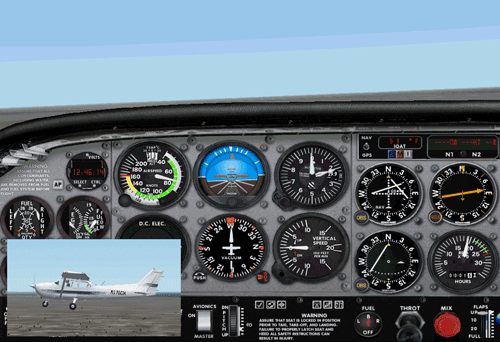
Leaving Slow Flight
Let’s suppose we’re following an airplane and the tower controller wants you to increase your speed from 75 to 85 knots. How do you accomplish this? Simply reverse the process used to enter slow flight.
To leave slow flight
- Increase power a bit, say to around 2000 rpm.
- Lower the nose just fast enough to keep the VSI needle steady at zero (or the altimeter’s hundred-foot hand steady).
- As the airplane accelerates, apply a little nose-down trim to help maintain the desired pitch attitude (which is approximately 6 degrees nose-up pitch, as shown on the attitude indicator).
- When the airplane is at the desired airspeed, apply enough power to hold your altitude. Use adjustments in pitch to maintain this airspeed.
- Make a final trim adjustment (if necessary) to maintain the pitch attitude, which gives you the airspeed you want (85 knots in this instance).
When exiting slow flight, your airplane should look something like the one in Figure 4-14.
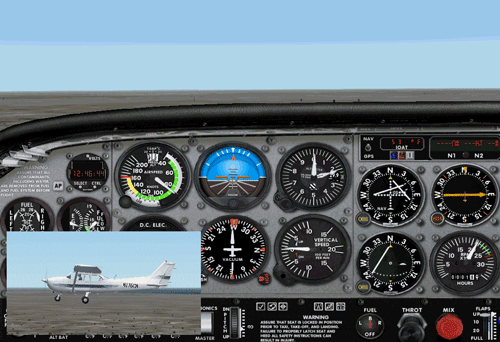
Maintaining Altitude at Cruising Speed
So far, you’ve examined how to fly the airplane at several different speeds. At this stage of your training, you should be aware that the throttle is best used to maintain your altitude or rate of descent. The airspeed is maintained by adjusting the airplane’s pitch attitude. But what about when you’re not trying to maintain a specific speed, such as in cruise flight? After all, in cruise flight, you don’t maintain your altitude using throttle adjustments, do you? No, you don’t. Here’s why.
In cruise flight, you typically set the throttle to a power setting that won’t harm the engine (for simplicity in teaching, we’ll assume that the application of full throttle in any of our simulations won’t hurt the engine). Then, for the most part, you leave the throttle alone. You’re not necessarily concerned with maintaining a specific airspeed in cruise flight. In this case, power is fixed at a specific setting, and you make slight adjustments in pitch attitude to hold or modify your altitude. In slow flight, however, you’ll use power to control your altitude and pitch (joystick) to control your airspeed. This might be the opposite of what you’d guess. As you’ll soon see, however, this is the basic technique I want you to use when landing an airplane.
You’re on Your Own
Now I want you to proceed to the interactive lesson and practice slow flight in the airplane. Your ultimate objective is to maintain altitude and heading while trying to fly at various slow flight-speeds. At first, you’ll find it a bit tricky to maintain airspeed and altitude while flying a precise heading. So establish your priorities as follows: First, adjust pitch to give you the airspeed you want. Then, while maintaining that pitch attitude, make small adjustments in power to hold your altitude.
If you feel lucky, try slow flight in turns. But be careful in those turns. Remember from Lesson 2 that a slight increase in pitch attitude was necessary to maintain altitude in a turn. Now that you know how to use the throttle, you’ll want to add a little bit of power, if necessary, to help maintain altitude in a turn. The steeper the turn, the more power you’ll need. Be generous with your use of trim in slow flight (although it’s best not to trim in turns since turns are transient conditions). This prevents the airplane slinking away from the pitch attitude you want if your attention is diverted from the instrument panel. Above all, have fun!
Click the Fly This Lesson Now link to practice what you’ve just learned.
Lesson 4: Slow Flight
In this lesson you’ll learn about flying the airplane at an airspeed just above stall speed.
ESTIMATED TIME TO COMPLETE
15 minutes
REQUIRED KNOWLEDGE/SKILLS
Reading the Ground School material before starting this lesson will help you better understand the skills being taught.
THE WEATHER
The sky is clear and the winds are calm.
RECOMMENDED CHARTS
None
ABOUT THE FLIGHT
You’ll start in the air at 4000 feet. You’ll learn about angle of attack and how to control the airplane as it flies close to stall speed.
KEY COMMANDS TO REMEMBER
None
FLIGHT CRITERIA
You’ll be asked to maintain:
- Altitudes within 200 feet of your assignment
- Power settings within 150 RPM as assigned
- Airspeeds no more than 10 knots above or 5 knots below as assigned
